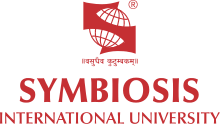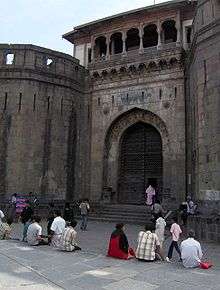Symbiosis International University
 | |
| Motto | Vasudhaiva Kutumbakam |
|---|---|
Motto in English | The world is one family |
| Type | Private |
| Established | 2002 |
| Chancellor | S. B. Mujumdar |
| Vice-Chancellor | Dr. Rajani R.Gupte |
| Location |
Pune, Maharashtra, India 18°32′15″N 73°43′53″E / 18.537479°N 73.731267°ECoordinates: 18°32′15″N 73°43′53″E / 18.537479°N 73.731267°E |
| Campus | Urban,multiples[1] |
| Mascot | The common man[2] |
| Affiliations | UGC, AICTE |
| Website | www.siu.edu.in |
Symbiosis International University (SIU) is a private coeducational, multi-institutional university located in Pune, Maharashtra, India. It has been given official recognition by the UGC and the AICTE. The National Assessment and Accreditation Council has conferred an 'A' grade to the university. SIU is part of the Symbiosis Society, which is its managing body.
The society was established in 1971 by Padmashree S. B. Mujumdar. It was given autonomous status in 2002 by the Ministry of Human Resources Development[3] and since then has opened many more institutes affiliated with it.
Symbiosis International University has 19 academic institutions[4] spread over nine campuses in Pune, Noida, Bangalore and Nashik.[1] All form part of the Symbiosis Society, with the other institutes in the society being affiliated with other bodies. The School of Law, School of Liberal Arts, Engineering, Management, Economics and Mass Communication are highly renowned institutions within the country. The Symbiosis Law School in Noida is also among the top law colleges in the country.
History
The first institutions belonging to the Symbiosis Society were established in 1971 and were affiliated to the University of Pune. Established in 1971 under the patronage of S. B. Mujumdar, president and founding director, the Symbiosis Society is registered under the Societies Registration Act, 1860 and the Bombay Public Trust, Act, 1950. The principal director is Dr. Vidya Yeravdekar.
In 2002, as part of a larger program to grant autonomy to institutions of academic excellence, the Ministry of Human Resources Development conferred the "Deemed to be University" status on three institutes under the Symbiosis umbrella: the Symbiosis Institute of Computer Studies and Research, Symbiosis Institute of Business Management(SIBM) and Symbiosis Society's Law College.[3] In 2006 the University Grants Commission withdrew the word "Deemed" and renamed the institution as "Symbiosis International University". The song of the university is composed and sung by Maharashtran singer/composer 'Sanjay Gite' with lyrics by Dr. Satish Kulkarni Pimpalgaonkar. [5]
Programmes and courses
The university offers a total of 71 programmes with 117 courses covering the fields of:
- Telecom Management
- Banking Management
- Economics
- Law
- Management
- Computer Studies
- Health Sciences
- Media, Communication, and Design
- Humanities
- Engineering
- Geoinformatics
- Language
- Photography
- Nursing
Campuses and institutes
Symbiosis has several campuses housing multiple institutes within each.
Lavale campus

- Symbiosis Institute of Business Management (SIBM, Pune)
- Symbiosis School of Banking and Finance (earlier known as Symbiosis School of Banking Management)
- Symbiosis Institute of Telecom Management
- Symbiosis Institute of Technology
- Symbiosis Institute of Media and Communication (PG)
- Symbiosis School of Biomedical Sciences
- Symbiosis School of Photography
- Symbiosis Summer School
- Symbiosis Centre for Management Studies
S. B. Road campus
- Symbiosis School of Economics
- Symbiosis Institute of Health Sciences
- Symbiosis College of Nursing
- Symbiosis College of Arts and Commerce
Atur campus
- Symbiosis Institute of Computer Studies and Research
- Symbiosis Institute of Geoinformatics
Centre Public School Kirkee
Viman Nagar campus, Pune

- Symbiosis Law School
- Symbiosis School for Liberal Arts
- Symbiosis Institute of Design
- Symbiosis Centre of Media and Communication (Under Graduate)
- Symbiosis Centre for Management Studies
Nasik campus
- Symbiosis Institute of Operations Management (SIOM, Nashik)
Symbiosis Institute of Operations Management (SIOM) is an educational institute located in Nashik, India. It offers postgraduate degrees in the fields of operations management and is part of the Symbiosis Society.
Hinjewadi campus
- Symbiosis Centre for Information Technology
- Symbiosis Centre for Management and Human Resource Development
- Symbiosis Institute of International Business
Model Colony campus
- Symbiosis Institute of Geoinformatics
- Symbiosis Institute of Computer Studies and Research
- English Language Teaching Institute of Symbiosis
- Symbiosis Center for Distance Learning
Range Hills campus
Bangalore campus
- Symbiosis Institute of Business Management
- Symbiosis Institute of Media and Communication
Noida Campus
- Symbiosis Law School
- Symbiosis Institute Of Business Management
Hyderabad campus
- Symbiosis Institute of Business Management
- Symbiosis School of Law
Symbiosis National Aptitude Test
The university conducts the Symbiosis National Aptitude Test (SNAP Test), a national level entrance examination[6] conducted in December for admission to MBA post-graduation programs run by the university's affiliated colleges.
Participating institutes and colleges
The following institutes conduct admissions using the SNAP Test:
- Symbiosis Centre for Information Technology
- Symbiosis Centre for Management and Human Resources Development
- Symbiosis Institute of Business Management, Bengaluru
- Symbiosis Institute of Business Management, Hyderabad
- Symbiosis Institute of Business Management, Pune
- Symbiosis Institute of Computer Studies & Research
- Symbiosis Institute of Health Sciences
- Symbiosis Institute of International Business
- Symbiosis Institute of Management Studies
- Symbiosis Institute of Media & Communication, Bengaluru
- Symbiosis Institute of Media & Communication, Pune
- Symbiosis Institute of Operation Management (Nashik)
- Symbiosis Institute of Telecom Management
- Symbiosis School of Banking and Finance
Format
The SNAP Test is an objective type paper-based exam. The duration of the exam is 2 hours. The paper is divided into four sections:[7]
- General English
- Quantitative Data Interpretation an Data Sufficiency
- General Awareness
- Analytical and Logical Reasoning
Reservation policy
The university follows the UGC Reservation Guidelines for the admission process through the SNAP Test. The reservations offered by the University are as follows:
- Scheduled Castes (SC) : 15%
- Scheduled Tribes (ST) : 14%
- Differently Abled : 3%
- Kashmiri Migrants : 2 seats per program
- International Candidates : 15%
See also
References
- 1 2 http://siu.edu.in/html/inner.asp?linkid=5
- ↑ "President of India K. R. Narayan will unveil an eight-feet-tall bronze statue of R. K. Laxman’s Common Man, the endearing character by India’s ace cartoonist, in front of Symbiosis Viswabhavan in Pune". The Tribune. 18 December 2001. Retrieved 16 January 2014.
- 1 2 Notification no F-9-12/2001/U-3, Under Section 3 of the UGC Act of 1956
- ↑ http://siu.edu.in/html/inner.asp?linkid=1
- ↑
- ↑ "SNAP Test Eligibility criteria, Pattern & Other details".
- ↑ SNAP Exam Pattern
External links
| ||||||
| ||||||||||||||||||||||||||||||||||||||||||||||||||||||||||||||||||||||||||||||||||||||||||||||||||||||||||||||||||||||||||||||||||||||||||||||||||||||||||||||||||||||||||||||||||||||||||||||||
